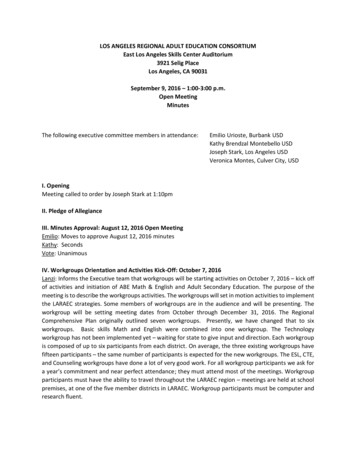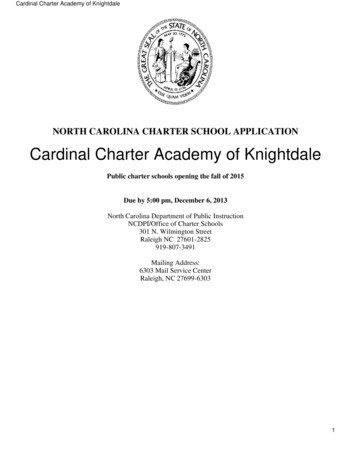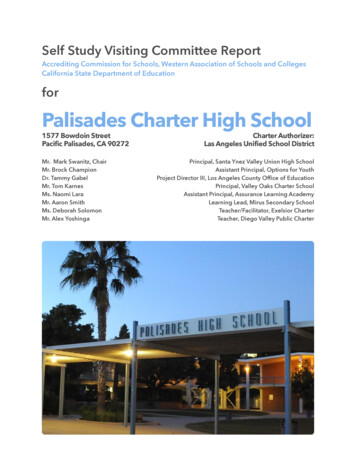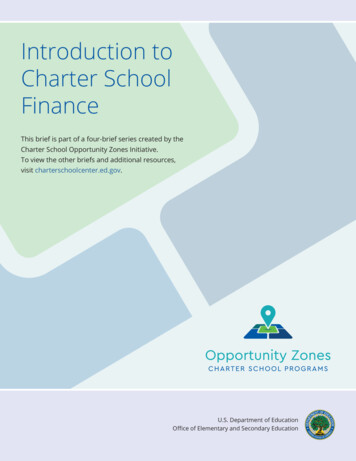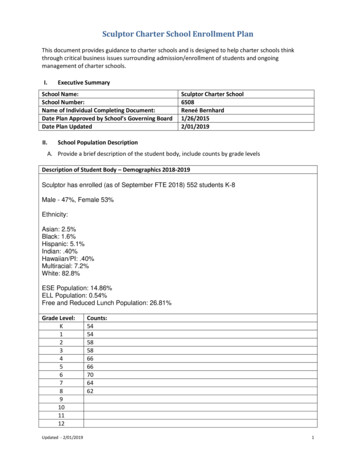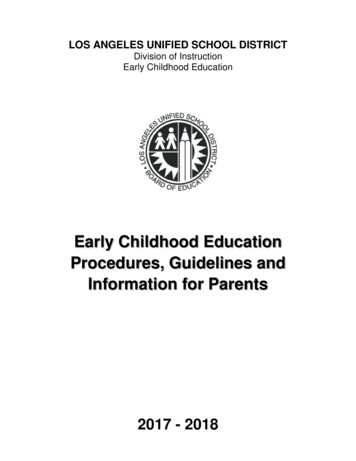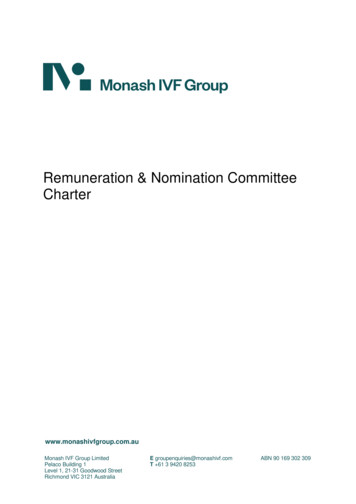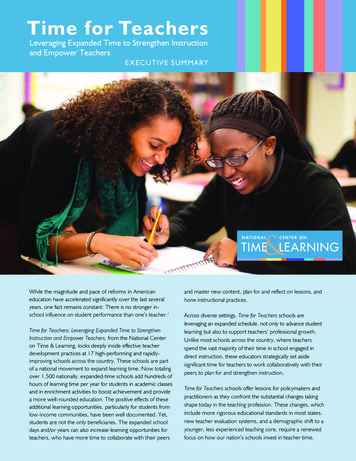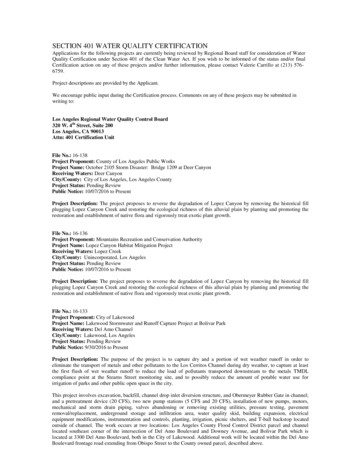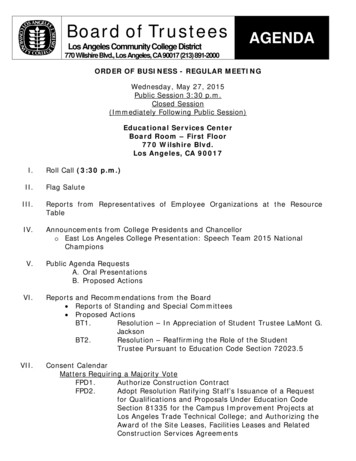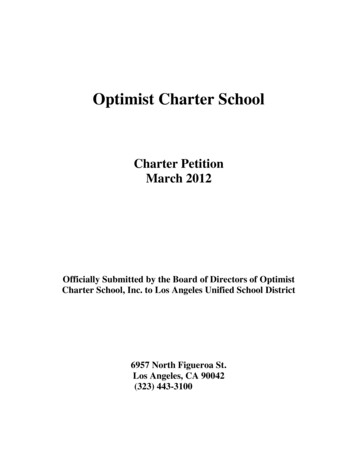
Transcription
Optimist Charter SchoolCharter PetitionMarch 2012Officially Submitted by the Board of Directors of OptimistCharter School, Inc. to Los Angeles Unified School District6957 North Figueroa St.Los Angeles, CA 90042(323) 443-3100
Table of ContentsInitial Screening ChecklistLetter of Intent1Charter Briefing Page2Affirmations and Assurances9Element 1: The Educational Program10A. Student Population to Be Served10B. Vision and Mission18C. What it Means to be an Educated Person in the 21st Century19D. How Learning Best Occurs20E. Goals of the Program22F. Instructional Framework – Program and Curriculum23G. Delineation of Core Subjects29Graduation Requirements30Scope and Sequence of Skills and California Content Standards32 English/Language Arts33 Mathematics35 Social Science/History39 Science41H. Adopted Textbooks for Instruction44I. A Typical Day at Optimist Charter School46J. Meeting Needs of Identified Populations49K. Implementation Plan and Timeline55L. Teachers56M. Academic Calendar and Bell Schedule58
N. Research and Conclusion60Element 2: Measurable Outcomes63Element 3: Methods by Which Student Outcomes Will Be Measured66Element 4: Governance68Element 5: Employee Qualifications77Element 6: Health and Safety83Element 7: Racial and Ethnic Balance91Element 8: Admission Requirements95Element 9: Financial Audits197Element 10: Student Expulsions100Element 11: Retirement Programs109Element 12: Attendance Alternatives110Element 13: Employee Rights111Element 14: Dispute Resolution112Element 15: Employer Status and Collective Bargaining114Element 16: Procedures to be Used if the Charter School Closes115Works Cited124Appendix 1: Facility Information Resolution from Board of Directors Conflict of Interest OYHFS Articles of Incorporation OYHFS BylawsAppendix 2: Budget and Financial Projections OYHFS Financial Documents Optimist Charter School Budget
Alternate BudgetAppendix 3: Board Members, Petitioners and Teachers Board Member Questionnaires and Resumes Lead Petitioners Due Diligence Questionnaires and Resumes Teacher Approval Signature Page Resumes of Interested TeachersAppendix 4: Emergency PreparednessAppendix 5: Optimist Charter School Documents
1 Page
CHARTER BRIEFING PAGEName of Organization Applying for Charter: Optimist Charter School under theauspices of Optimist Boys Home and Ranch, Inc. Dba Optimist Youth Homes and FamilyServices.Grades Served-Year 1: 7 - 12 Grades Served-Year 5: 7 - 12Number of Students- Year 1: 120 Number of Students -Year 5: 144Location Address or Target Neighborhood:The target location is within possible 5 mi radius of our current location, 6957 N. FigueroaSt., LA 90042.Facility Status/Location:Our facility is located at 6957 N. Figueroa St., L.A. 90042, which is located in HighlandPark, 7 miles northeast of downtown Los Angeles. Optimist Nonpublic High School iscurrently certified by the State Department of Education and has a fire clearance for 300students. No physical changes will be needed to open our charter school.Prop. 39 –Application Submitted?Prop. 39 application is not being submitted.Does the location meet Board Policy? (Low API, Overcrowded):Optimist Charter School’s location will meet the Board policy related to low API andovercrowded school relief. Eagle Rock H.S. has an API score of 715, Franklin H.S. has anAPI of 659, and Luther Burbank has an API score of 663. However, the majority of ourresidential students’ parents do not live within this community.BOARD OF DIRECTORS 2011-12(Revised 08-01-11)OFFICERSPRESIDENTRetired Police OfficerVICE PRESIDENTComputerEngineeringMcWEENEY, TERRY10538 Stonybrook AvenueSouth Gate, CA 90280SNYDER, BILL930 Jacon WayPacific Palisades, CA 90272Res: (562) 869-4202Fax: (562) 869-7852Res: (310) 454-2732Cell: (310) 259-7596Fax: (310) 230-13062 Page
VICE PRESIDENTRetired VP, Furniture SalesMONIZ, NORBERT27976 Red Pine Ct.Valencia, CA 91354TREASURERLAU, LELANDCertified Public Accountant 3056 West Main StreetAlhambra, CA 91801SECRETARYAdvertising BusinessGADBURY, DOLORES “Dee”28109 Tenda DriveCanyon Country, CA 91351Res: (661)263-6677Fax: (661) 263-1789Cell: (661) 678-3637Bus: (626) 458-528/8528Fax: (626) 458-532Cell: (213)479-3308Res: (661) 252-7313Cell: (661) 713-6642DIRECTORSCouncilman HuizarField DeputyANDALON, DANIEL S.6428 La Riba WayLos Angeles, CA 90042Res (323) 258-6010Cell (323) 376-0011New Truck SalesANDOLSEK, DENNIS7245 Magruder StreetLa Mesa, CA 91942Bus: (858) 222-8330Res: (619) 463-4906Fax: (858) 222-8339Cell: (619) 861-9472AttorneyAUSTIN, GARY S.1923 W. 81st StLos Angeles, CA 90047Bus: (310) 277-9595Cell: (310) 292-6435RetiredBINCH, FRANKP.O. Box 4066Diamond Bar, CA 91765Commercial Real EstateBROWN, LARRY1010 No. Bundy DriveLos Angeles, CA 90049Res: (310) 476-5739Fax: (310) 471-7500Retired Eligibility Worker CARTER, TEDPSE District Representative 2561 Oregon AvenueLong Beach, CA 90806Res: (562) 427-4211Fax: (562) 427-4211Res: (909) 861-67453 Page
US Bank, Vice PresidentDIAZ, CARLOSUS Bank1153 Fair Oaks Ave.South Pasadena, CA 91030Bus: 626-403-7900Cell: 626-523-0900Retired Staff Assistant toCounty SupervisorDUBEN, PAMELA30535 Hasley Canyon RoadCastaic, CA 91384Res: (661) 257-6867Retired ContractorFOX, JESSE820 E. Verdugo AvenueBurbank, CA 91501Res: (818) 845-5255Retired ContractorHUNT, ED1538 BellefontaineRiverside, CA 92506Res: (951) 682-0327Cell: (951) 522-2549Chief of Police, LBMcDONNELL, JIM400 W. BroadwayLong Beach, CA 90802Bus: (562) 570-7301Fax: (562) 570-7114AttorneyNIEDERBERG, RICHARD Esq.P. O. Box 1883Studio City, CA 91614-0883Bus: (323) 650-9600Fax: (323) 654-3210TDD: (323) 654-2700Semi-Retired BusinessOwnerVILLACHICA, RON10754 Burbank Blvd, #BNorth Hollywood, CA 91601Bus: (818)763-1283IMMEDIATE PAST PRESIDENT (and current board member)Retired High SchoolAdministratorBERTRAND, BILL10025 Roscoe Blvd.Sun Valley, CA 91352Res: (818) 767-51134 Page
Description of Mission:The mission of Optimist Charter School is to provide a motivating educational opportunityand integrated support services for young men and women, especially those experiencingchallenging life circumstances who are placed by the Department of Probation in fostercare homes and placements. Our students will include young men and women in the fostercare and probation systems who have experienced a lack of success in the traditionaleducational environments. Our mission is to provide quality academics in a safe, structuredsetting that also provides therapeutic behavioral intervention and social skills training topromote educational success.Description of Vision:Our vision is to empower probation foster youth students to become self-reliant by helpingthem develop the skills, ambition, and self-confidence necessary for productive, successfullives. We intend to give them the tools for future academic success that will allow them toreach their potential.Source/Core of Money:Since we have been operating a nonpublic school for over 21 years, we have the necessarysite, furniture, equipment, and most of the curriculum necessary to open our charter school.Additionally, some of our current Nonpublic School teaching staff will transfer to thecharter school and only a few staff will require recruitment and training. Thus, ourexpenses for opening the charter school will be minimal. We currently have 550,000invested in mutual funds, 550,000 in a certificate of deposit, and just over one milliondollars in a line of credit for start up and operational costs. We are submitting two previousyears of independent audits. See Appendix 2.Top Leaders/Charter Development Team: Alan Eskot has been working in the nonprofit sector for 39 years. His first 5 yearsin the field were spent as a special education teacher in a nonpublic school, and for the past31 years, he has been the Director of Education for three residential nonpublic schoolprograms, all of which he established. He has been the Director of Education at OptimistHigh School since September 1990. Additionally, he has consulted with many agencies andhas assisted in opening up 18 nonpublic school, most of them being in residential facilities.Alan has been very involved with special education policy and has served on several localand state committees regarding these issues. He graduated with a Bachelor of Arts degreein Psychology from UCLA and a Master of Arts degree in Clinical Psychology from theCalifornia State University, Los Angeles. Silvio Orlando has worked in the field of child welfare since 1970. He worked as achild care worker, social worker, social work supervisor, residential director, and assistantexecutive director in Montreal, New York, and Los Angeles before becoming our executivedirector in 1999. Sil received his Masters of Arts Degree in Social Work (MSW) fromBoston College. He is also a past president of the California Alliance of Child and Family5 Page
Services and is currently the president of the Association of Community Human ServiceAgencies here in Los Angeles. Doug Buttrick is a financial executive with over 36 years of experience. He hasworked in both the private and non-profit sectors for a variety of companies in Boston,New York, San Francisco and Los Angeles before becoming our Chief Financial Officer in2003. Doug graduated Magna Cum Laude with a Bachelor of Science degree inAccounting from Northeastern University in Boston, Massachusetts. Lynn DeYoung has been a Vice Principal at Optimist Nonpublic High School forthe last 21 years. Prior to that, she worked for three years as a counselor and teacher withprobation youth. She has her Single Subject Teaching Credential in English and has beenthe chair of the English Department at Optimist. In the last ten years, Lynn has been closelyinvolved in the IEP process for students at Optimist. She has extensive experience inidentifying students with special needs, preparing SST documents and participating in SSTmeetings, writing IEPs, and participating in IEP meetings. Lynn also has her Masters ofArts in Theatre and has a great deal of experience directing high school students intheatrical productions as well. Bill Bertrand is a retired teacher and principal who worked for 17 years forBurbank Unified School District. He has been on the Board of Directors of Optimist YouthHomes and Family services for many years and was recently the President of the Board forthree years.Has your charter applied to any other jurisdiction for approval?Optimist has not applied to any other jurisdiction for approval.Are there any sister charters? There are no sister charters.What innovative elements of your charter could be considered “best practices” andreplicated by other schools? Small Class SizeOptimist has been operating a nonpublic school for over 21 years and has extensiveexperience working with the targeted population of foster youth placed by probation infoster placement. One of the aspects of our nonpublic school program that is very effectiveis using small group classes to teach the core curriculum in a departmentalized setting. Wewill maintain core curriculum instructional groups of between 8 and 10 students perteaching personnel. Using small groups for instruction allows teachers to providedifferentiated instruction as necessary, paying attention to each student, prompting andassisting those who need additional help, and knowing each student well so each teachercan intervene when either behavioral or academic problems arise.6 Page
Behavioral Intervention and Social Skills TrainingOptimist Charter School intends to institute a school-wide behavior management systemthat includes clear defined expectations and concrete rewards to encourage both workproductivity and positive appropriate school behaviors. Our nonpublic high school has beenusing this system with a great deal of success with our special education students in thenonpublic school setting for the past 21 years. We have found it to be very effective atmanaging problem behaviors and effecting change in students who have previous historiesof difficulty in school in the past. Our two-tiered positive token economy system will bemodified slightly to meet the needs of our targeted population of general education studentsand special education students with either RSP or SDC setting requirements. In addition,the small setting will allow for the development of relationships that promoteunderstanding and a cooperative learning environment. In our type of setting, teachers canbe role models of appropriate interactions and can provide constructive feedback. Crisis Management and Therapeutic Crisis InterventionMany of the students placed by probation in foster care have difficulty with angermanagement and exhibit volatile behaviors at times. Optimist has many years of experiencein working with this population and understands the unique needs of foster youth onprobation. All of our staff will be trained in PRO-Act techniques of crisis intervention. Thegoal is to provide a safe and structured setting where students can learn and know they willremain safe and protected. Our teachers learn to recognize trigger behaviors and tointervene quickly before conflict escalates to assaultive behaviors. However, shouldviolence ensue, they are also trained in safe methods of intervention and restraint whenabsolutely necessary. Our training instructs staff how to intervene in the types of crises thatrequire empathic understanding rather than physical intervention. Vocational Education and Work ExperienceIdentifying current academic goals and future career goals will be an important feature ofthe program. Students will complete vocational and career interest inventories and/orassessments to identify vocational areas of interest and strengths. Students will explorepotential careers within those fields of interest. Career oriented classes in basicconstruction, auto mechanics, computers, and computer graphics will expose students tothese vocations. Working in our cafeteria, auto shop, and recreation departments will allowstudents a real life experience and will assist in learning a multitude of skills necessary forwork in the community. Students earning a high school diploma will receive assistancewith enrolling in a trade school or college as they prepare to graduate.7 Page
OPTIMIST CHARTER SCHOOL PETITIONThe address of the Charter School is 6957 N. Figueroa St., LA, CA 90042.The phone number of the Charter School is 323-443-3100.The contact person for the Charter School is Alan Eskot, Dir. of Ed. or Lynn DeYoung,Principal.The term of this charter shall be from August 15, 2012 to June 30, 2017.The grade configuration is 7th through 12th grades.The number of students in the first year will be 120.The grade level(s) of the students the first year will be 7th through 12th.The scheduled opening date of the Charter School is August 15, 2012.The admission requirements include: Students in 7th through 12th grades Students who are probation placed foster youth living in a foster home, group home, orresidential facilityThe operational capacity will be 160.The instructional calendar will be: August 15, 2012 through June 30, 2013, 180instructional days which will closely approximate LAUSD’s regular track calendar.The bell schedule for the Charter School will be: 8:00 to 3:00, with 380 instructionalminutes.If space is available, traveling students will have the option to attend.8 Page
AFFIRMATIONS AND ASSURANCES:Optimist Charter School shall: Be nonsectarian in its programs, admission policies, employment practices and all otheroperations. Not charge tuition. Not discriminate against any student on the basis of disability, gender, nationality, race orethnicity, religion, sexual orientation, or any other characteristic that is contained in thedefinition of hate crimes set forth in Section 422.55 of the Penal Code. Admit all pupils who wish to attend the school. EC 47605(d)(2)(A) (See admissionscriteria.) Determine admission by a public random drawing, if the number of pupils who wish toattend the school exceeds the school capacity, and preference shall be extended to pupilswho currently attend the Charter School and pupils who reside in the District. EC47605(d)(2)(B) Not enroll pupils over nineteen (19) years of age unless continuously enrolled in publicschool and making satisfactory progress toward high school diploma requirements. Not require any child to attend the Charter School nor any employee to work at thecharter school. In accordance with Education Code Section 47605(d)(3)], if a pupil is expelled or leavesthe charter school without graduation or completing the school year for any reason, thecharter school shall notify the superintendent of the school district of the pupil’s lastknown address within 30 days, and shall, upon request, provide that school district with acopy of the cumulative record of the pupil, including a transcript of grades or report card,and health information.9 Page
INTRODUCTIONThe mission of Optimist Charter School is to provide a motivating educational opportunityand integrated support services for young men and women, especially those experiencingchallenging life circumstances. Our students will include young men and women in thefoster care system placed by the Department of Probation who have been unsuccessful intraditional educational environments. Our mission is to provide quality academics for fosteryouth in a safe, structured setting that also provides therapeutic behavioral intervention andsocial skills training to promote educational success. We hope to create a model programfor foster youth students that can be replicated throughout the state.Element 1 – The Educational Program“A description of the educational program of the school, designed, among other things, toidentify those whom the school is attempting to educate, what it means to be an ‘educatedperson’ in the 21st century, and how learning best occurs. The goals identified in thatprogram shall include the objective of enabling pupils to become self-motivated,competent, and lifelong learners.” Ed. Code §47605 (b)(5)(A)A. Student Population to be ServedOptimist Boys Home and Ranch dba Optimist Youth Homes and Family Services will beoperating Optimist Charter School. We have been operating a nonpublic (NPS) specialeducation school for the past 21.5 years and plan on continuing to operate this school in aseparate building on our premises. Our NPS will continue to serve students with IEPswhich delineate nonpublic school placement. Our proposed Charter School will servestudents who reside in the community and are placed by the Department of Probation ineither foster, group home, or residential homes. We will serve students who are in 7th to12th grades.Optimist Youth Homes & Family Services (OYHFS) is a nationally accredited non-profit501(c)3 corporation. We are one of the oldest and largest agencies of this kind in SouthernCalifornia, having opened our doors to orphaned boys in 1906 and incorporated in 1914 asa home for boys. That original site is our main residential campus for boys in Los Angeles.Referrals are accepted from throughout the state of California. We serve over 500 at-riskyouth and their families everyday. Optimist Youth Homes & Family Services providesculturally sensitive, comprehensive treatment, specialized education, and support servicesto abused, neglected or at-risk children, youth and their families, to promote stability withinfamilies and communities. The agency is committed to giving all children the chance at abright future which they so fully deserve. In combining therapy, education and a nurturingresidential living environment, we provide the specialized care and understanding neededby each and every child. Through life skills training, we aim to help young peopleovercome the negative experiences of their youth in order to lead meaningful, independentadult lives.10 P a g e
The main campus is a rate care level 12 facility that houses up to 99 adolescent males agetwelve to nineteen, who live in one of five dormitories or in one of three independent livingunits. These young men are referred by county Departments of Probation in Southern andNorthern California. In addition, Optimist Youth Homes & Family Services owns andoperates four community group homes in Los Angeles County, each housing sixadolescents. Two of the homes are for girls and two for boys, and they are also staffed byyouth care counselors and a social worker.Our nonpublic school has served a probation foster youth population for the past 21.5years. We have utilized a CDS classroom on our campus for the past 5 years as well asenrolling some of our students in our public school, Eagle Rock H.S. After all these yearsof educating these residentially placed Probation youth, it is our conclusion that this type ofpopulation needs to be in a sequestered educational setting. It is our mission to work withthis type of probation foster youth in and around our area.A precedent for preferential enrollment in a charter school within LAUSD has alreadybeen established. New Village Charter School in LA, which is associated with SaintAnne’s residential facility, only accepts female students. It is our desire to request asimilar preference for foster care students who are placed by the Department of Probationin similar foster, group, or residential homes within our community.Eagle Rock High School, a span school serving 7th to 12th grade students in the area, is thehome school for the residents of the Optimist residential facility. Other public schools inthe area are Franklin High School and Luther Burbank Middle School. Two charter schoolsin the Eagle Rock serving similar populations as the public schools are the CaliforniaAcademy of Liberal Studies located at 7350 North Figueroa St., and the Renaissance ArtsAcademy at 1800 Colorado Blvd. Below is demographic data for those schools.DEMOGRAPHIC INFORMATION FOR PROSPECTIVE SITE(Surrounding Schools Data)LAUSDSCHOOLSLutherBurbank MS.Eagle RockHS.Franklin HSCHARTERSCHOOLSAcademy ofLiberalStudiesRenaissanceArtsAcademy# ofStudentsMultitrackSchoolAPIScoreAPI SchoolsRank% of SpecialEd. Students% of E.L.L.Students% MajorEthnicity#1%MajorEthnicity#2% MajorEthnicity#32%StudentsEligible forFree Lunch8115232641113659244%Filipino18.8 %Filipino3.1 %Filipino2.3 % AA590 %Hispanic65.6 %Hispanic90.8 %HispanicNo8619/1081 %0.1 %94.9 %Hispanic2.6 %White1.6 % AsianNo8861065 %7%5%55 %Hispanic29 %White10 % AA2211 P a g e8.4 % White2.7 % Asian
Although some of this demographic data is relevant in relation to those youths who resideat Optimist, much of it is not, since our residents are placed by the Department of Probationin our facility. The young men and women who are placed in the Optimist residentialprograms are placed here from a variety of counties throughout the state. Approximately70% of our clients are placed by LA County and 30% by other counties. Most of the Outof-County clients come from Riverside and San Bernardino, but we have Orange County,Alameda County, San Joaquin County, Kern County, and Ventura County clients as well.Over the last 4 years, approximately 52% of our clientele are Hispanic, 29% AfricanAmerican, about 12 % are Caucasian, 2% list themselves as multicultural, and the other 5%include Asian, Native American and other ethnicities. Because they are placed by thesevarious probation departments, we have constant enrollments and discharges. With a totalof 123 beds in our dorms, group homes, and Independent Living Program, Optimist hasserved an average of 416 residents per year in the last four years, from January of 2007through December of 2010.Over the last three years, 2008 through 2010, the average length of stay for clients in theseresidential programs has been 4.6 months. This includes clients who may run away or beterminated because they are unable to abide by the rules of the program in the first fewweeks of placement. For those who are able to successfully remain in placement beyondthose first thirty days, the length of stay increases to about 6 months. Unfortunately, foryoung people whose lives have been subject to a great deal of mutability already,residential placement is destined to be another relatively short time of stability and respite.This is one of the reasons Optimist is applying for a Charter School in order to provideintensive rehabilitation and stability in an alternative, structured and nurturing schoolenvironment geared to providing both the necessary educational components andbehavioral intervention for students similar to ours. This Charter School will be modeled inpart on our current NPS, which has been a successful part of the Optimist facility for thelast 21 years.We will continue to operate our Nonpublic School (NPS), which was opened 21 years agoon September 28, 1990 and will be located in a separate building on campus. We are astate certified nonpublic special education school, which contracts with a variety of schooldistricts including: Los Angeles, Pasadena, Inglewood, Long Beach, and Glendale UnifiedSchool Districts. It serves some of our residential and group home clients and up to 80community students who qualify for special education and have IEPs stipulating NPS.Eighty percent of our community students were previously in our residential program andnow live within our transportation boundaries. The other educational programs operatingon our campus, is an LAUSD Community Day School (CDS) classroom, which offers upto 21 of our residents a regular education public school experience. Some of the residentswho do not have special education services are scholar-shipped in the nonpublic schoolwhen their histories indicate that they have had unsuccessful experiences on previouspublic school campuses, and therefore will most likely continue poorly. In these cases theparent/guardian has agreed to placement in that program. Many of these also have12 P a g e
significantly below average academic test scores as well. Some of these students are in theprocess of being tested and evaluated by LAUSD for special education.Finally, we also utilize full time placement at public school for some of our residents whohave been able to successfully handle this type of public school environment in the past.Most of the residential students who attend the local public school, Eagle Rock HighSchool have had relatively positive prior school histories and are not significantly behind intheir credits. Some of these students have IEPs and are receiving either RSP or SDC specialeducation services on the public school campus. However, many of these students continueto have some difficulty in the public school setting.Of those who enter the Optimist Residential Program, about 25% were receiving sometype of special education services prior to placement. However, most of the other 75%have a variety of long-term educational difficulties. A significant number of our residentshave a history of poor and failing grades, suspensions and expulsions from school,significant truancy, and behavioral and emotional difficulties in various school settings.Of those residents who do not have special education services, 77% fall into the 15 to 17year old age bracket and should chronologically be in the 10th to 12th grades. Of that group,approximately 57% enter Optimist with fewer than 30 credits. Of those who enter in thechronological 11th and 12th grades, only 10% have 90 or more credits and are therefore notclose to earning a regular high school diploma. Some of this group may be close to earninga high school diploma through AB167, but even then, many of those students do not havethe essential credits to meet those requirements prior to their expected graduation date.Our statitistics are consistent with those of other residentially placed youth throughout thecountry. According to the Survey of Youth in Residential Placement: Youth Needs andServices (SYRP) by Andrea J. Sedlak , Ph.D. and Karla McPherson, Ph.D., a survey ofmore than 7,000 youth in custody in 2003, 49% of 15 years olds are below modal gradelevel, and this number steadily increases with the older population. “The percentage belowmodal grade level leaps upward from an already high level (50% of the 17-year-olds) toclose to two-thirds of the 18- to 20-year-olds.” The dropout rate for overall custodypopulation (ages 10 through 20 in SYRP) is more than three times higher than the eventdropout rate for students in grades 10 through 12 in the general population.”Related to the problem of grade level and poor credit accrual for the foster child inresidential placement is the problem of transience. According to the FAQ Sheet for AB167:California’s foster children are often bounced from placement to placement and fromschool to school. These transitions often result in education related problems, includinga loss of school credits, academic problems, and a delay in earning a high schooldiploma. Studies show high school pupils who change schools even once are less than50 percent as likely to graduate from high school as compared to high school pupils whodo not change schools (1).13 P a g e
Optimist residents’ records, for example, clearly provide evidence of this. The “normal”child whose family does not move about attends three schools before graduating, anelementary school, a middle school, and a high school. Only about 4% of Optimistresidents have that type of enrollment histories. Disconcerting and troubling is that an equalpercentage of our clients have attended more than 10 schools! The vast majority fall in themiddle. Forty-five percent of our residents have attended four to six schools, and almosthalf, 46%, have been enrolled in seven to ten different schools during their lives prior totheir placement at Optimist. Ready to Succeed, a study of foster care youth in California,shows similar data. In a list of statistics regarding foster youth, it notes that Californiast
Optimist Charter School Optimist Charter School Charter Petition March 2012 Officially Submitted by the Board of Directors of Optimist Charter School, Inc. to Los Angeles Unified School District 6957 North Figueroa St. Los Angeles, CA 90042 (323) 443-3100 Table of Contents
